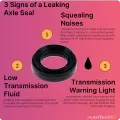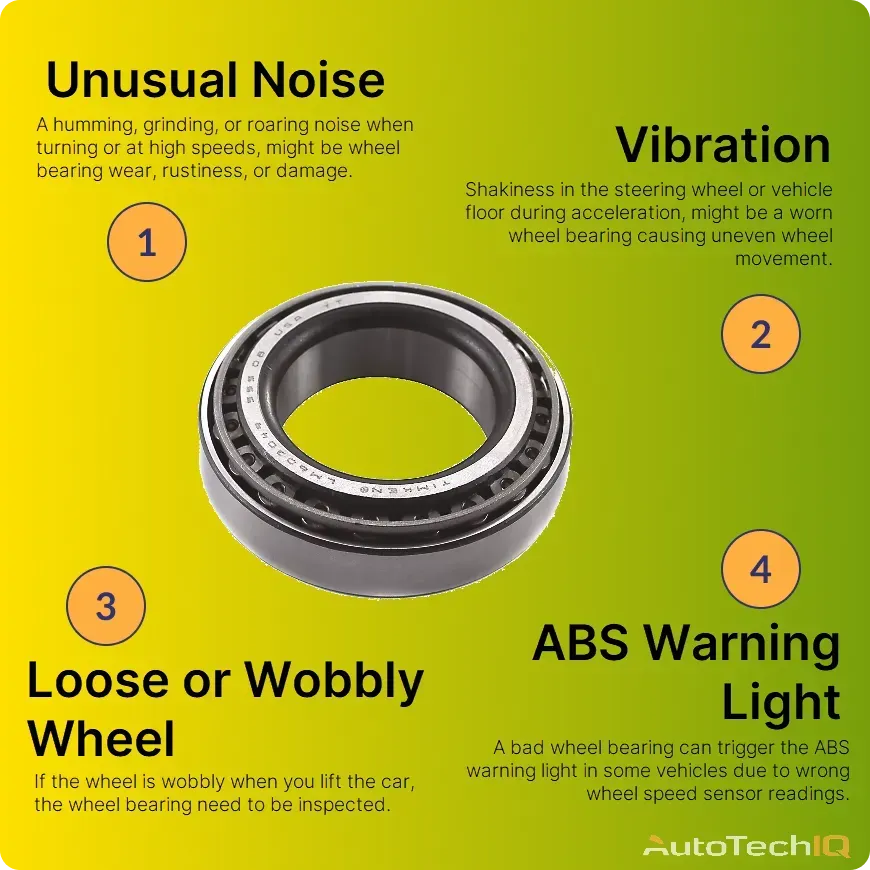
The wheel bearing is a steel-colored disc-like thick metallic plate that stays behind the wheels. This part's interior has steel balls and rollers tightly packed inside and out of sight. This entire structure results from precise engineering studies; basically, the steel balls and rollers inside the bearing help reduce friction and improve wheel rotation. Consequently, wheels become durable, safe, smooth, and capable of managing tons of weight.

Can you drive a car with a bad wheel bearing?
No, driving a car with a bad wheel bearing is unsafe. A damaged wheel bearing won't handle friction, resulting in too much heat; overheating this system can end up with wheel separation mid-traffic. Even if it doesn't get to that, a bad wheel bearing worsens the vehicle's steering, increases accident risks, and damages other components.
What is the life expectancy of a wheel bearing?
The life expectancy of a wheel bearing depends on the product's quality, driving conditions, and maintenance. A well-maintained wheel bearing lasts between 85,000 to 100,000 miles (137,000 to 160,000 kilometers). Still, noticing signs of wear, such as unusual noises or vibrations, hints that the wheel bearings require maintenance; these symptoms can pop anytime. Regular maintenance, proper lubrication, and driving safely can extend the lifespan of wheel bearings.
What's the worst that can happen with a bad wheel bearing?
The worst-case scenario if you're driving with a bad wheel bearing is a catastrophic failure. Here are some potential outcomes:
-
Loss of Vehicle Control: A severely worn or damaged wheel bearing can cause the wheel to wobble or even separate from the vehicle. This loss of control can result in a dangerous accident.
-
Wheel Separation: In extreme cases, a bad wheel bearing can lead to the wheel separating from the vehicle while in motion, posing a significant safety hazard to you and others on the road.
-
Damage to Other Components: Driving with a bad wheel bearing can stress other parts of the wheel assembly, including the hub, spindle, and brake components, potentially leading to expensive repairs.

-
Increased Friction and Heat: A deteriorating wheel bearing generates increased friction and heat, which can cause further damage and potentially lead to a wheel fire.
-
Uneven Tire Wear: Bad wheel bearings can cause tires to wear unevenly, reducing tire lifespan and affecting vehicle handling.
A bad wheel bearing causes loss of vehicle control, wheel separation, damage to other components, overheating, and uneven tire wear. This type of issue can develop into hefty repair costs and safety risks.
How long can you drive on a noisy wheel bearing?
The noise means something is wrong, so you shouldn't keep driving. The noise is typically because of a bearing problem. Driving with a damaged, noisy wheel bearing results in more damage, risking safety and future repairs.
But, if you can't simply stop driving due to the noisy wheel bearing, you might still have some time before serious damage pops up. A short drive to a safe location or repair shop should be fine. But, routine daily drives to run unrelated errands can be risky.
Common Symptoms of a Wheel Bearing Needing Service
Unusual Noise: Grinding, roaring, or humming noises, especially when turning or at higher speeds, are common signs of a worn wheel bearing. This noise indicates friction and should not be ignored.
Vibration: Excessive vibration felt through the steering wheel or the vehicle's floor, especially at certain speeds, can indicate a wheel bearing issue. It results from uneven wheel rotation.
Loose or Wobbly Wheel: A wheel with excessive play or wobbling when jacked up or shaken indicates a deteriorating wheel bearing that needs attention.

ABS Warning Light: A failing wheel bearing can trigger the vehicle's anti-lock braking system (ABS) warning light as it affects wheel speed sensor readings.
Uneven Tire Wear: Uneven tire wear, particularly on one side of the vehicle, can suggest a problem with a specific wheel bearing, as it affects the alignment and tire contact.

Pulling or Drifting: A vehicle might pull to one side or exhibit unstable handling when a wheel bearing is worn or damaged, impacting proper wheel alignment.
Overheating: A hot wheel or brakes after driving can indicate excessive heat generated by a malfunctioning wheel bearing. This condition can lead to further damage if not addressed.
Difficulty Steering: Difficulty steering, especially when turning, can occur due to a wheel bearing issue, as it affects the smooth rotation of the wheel.
Act quickly if you notice any of these symptoms from your car. More problems can appear frequently after initial symptoms.
How customer education happens when dealing with a faulty wheel bearing.
Exemplary auto shops perform vehicle services focusing on the customer's trust; they follow a process in which the customer receives images and information about anything done on their car. This customer-oriented service informs car owners of the issue and how to avoid it.
Let's see how this type of service goes by creating a fictional customer and technician interaction.
Sarah brought her SUV for a routine check-up at Mark's auto shop. She mentioned a humming noise while driving. Like many car owners, Sarah wasn't sure what to expect from the repair process.
The technician, Mark, welcomed her. His line of work is giving customer education to ensure transparency and trust.
Test: Mark performed a test drive to verify the humming noise and found that the noise was from the right front wheel and became louder when turning left.
Inspect: Mark lifted Sarah's SUV on the shop's lift for a thorough inspection. Mark had an assistant, Steve, video him as he pushed the right front wheel top to bottom and rotated the tire; some noticeable growling and loose movement were present. Mark then showed Sarah the video and images of the failing wheel bearing. He explained the visible damage and sound from the right front wheel bearing. Sarah could clearly see from the video and images that the wheel bearing was faulty.
Evaluate and Diagnose: Mark checked all wheels for movement and noise and found that the right front wheel bearing was the only one that had failed. Mark also found no damage to the brake systems and wheel speed sensor. Mark showed Sarah the inspection images, proving no other damage was present. He recommended a wheel bearing replacement to prevent further damage to other components and ensure her safety on the road.
Confirm Repair: Mark discussed the replacement process, detailing the steps and how long it'll take. He provided Sarah with the cost of parts and labor, assuring her that they only used high-quality, reliable bearings. Sarah felt well-informed and confident in Mark's expertise.
With Sarah's approval, Mark and his team replaced the wheel bearing. Throughout the process, he updated Sarah, showing her the old, damaged bearing once removed.
Mark's dedication to educating his customers resolved Sarah's issue and strengthened the bond of trust between the shop and its valued clients.
Top 5 Causes of Symptoms for Wheel Bearing Replacement
Unusual Noise: A humming, grinding, or roaring noise, especially when turning or at high speeds, signifies potential wheel bearing wear or damage requiring replacement.
Vibration: Excessive vibration felt in the steering wheel or vehicle floor, particularly during acceleration or at specific speeds, suggests a worn wheel bearing necessitating replacement.
Loose or Wobbly Wheel: A wheel exhibiting play or wobbling when raised or shaken typically indicates a deteriorating wheel bearing that should be replaced for safety.
ABS Warning Light: A malfunctioning wheel bearing can trigger the ABS warning light due to erratic wheel speed sensor readings, indicating a need for replacement.

Uneven Tire Wear: Uneven tire tread wear, especially on one side of the vehicle, may result from a failing wheel bearing affecting alignment and requires replacement to prevent further damage.
Top 5 Fixes for a Bad Wheel Bearing:
Wheel Bearing Replacement: Replacing worn or damaged wheel bearings eliminates noise and vibration and ensures smooth wheel rotation.
Hub Assembly Replacement: Replacing the entire hub assembly, including the wheel bearing, to simplify installation and ensure proper alignment and performance.
Wheel Alignment: Performing a wheel alignment after replacing a wheel bearing to restore proper wheel positioning and prevent uneven tire wear.
Brake Inspection: Inspecting and, if necessary, replacing brake components like rotors and pads that may have been affected by a bad wheel bearing.
ABS Sensor Replacement: If the wheel bearing issue triggered the ABS warning light, replacing a faulty ABS sensor ensures accurate wheel speed readings and system functionality.

Summary
This article explains the role of wheel bearings in providing safe and smooth vehicle movement on the road. It discusses the signs of a failing wheel bearing, such as unusual noises and vibrations, and the importance of prompt replacement. The article also educates readers about the consequences of ignoring wheel-bearing issues, including loss of control and expensive repairs. Raising awareness about wheel bearing maintenance encourages responsible vehicle ownership and emphasizes safety on the road.
Discover high-quality service and trusted automotive shops near you by visiting our "Shop Near You" page.
The fictional service between Sarah and Mark discussed above is based on true interactions. We understand the importance of transparency and educating our customers. Informative inspection images are featured in all our articles to strengthen that. Whether you need a routine check-up or specific repairs like wheel bearing replacement, we have a list of reputable shops that provide top-notch service. Explore the expertise and reliability of local automotive professionals who focus on your safety and satisfaction. Don't miss out on the opportunity to experience peace of mind on the road; visit our "Shop Near You" page today!
Other news
-
Car is Squealing When Driving
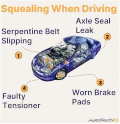
-
What is Preventative Maintenance and What Are The Benefits of it?

-
JobViewIQ - DVI Process Training - Part of the Auto Care Alliance Benefits

-
7 Signs of AC Pulley Issues
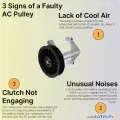
-
7 Signs of Clogged AC Components
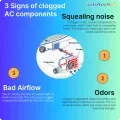
-
How Much Does a Transmission Fluid Change Cost?
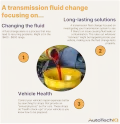
-
7 Signs of a Leaking Axle Seal
